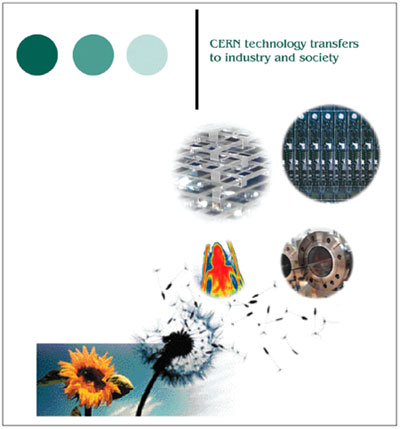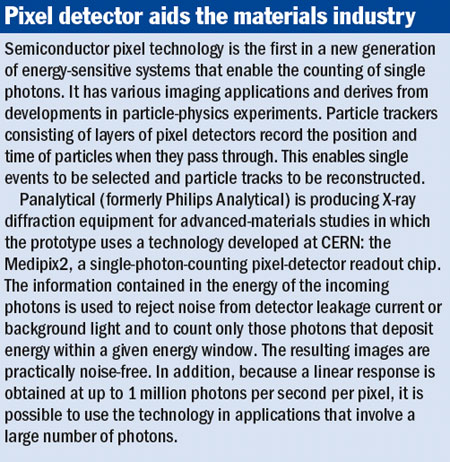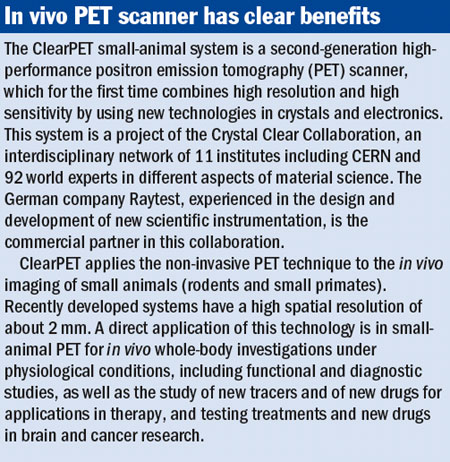The ever-increasing high-technology requirements of particle-physics research provide a fertile ground for CERN’s Technology Transfer Group, as Beatrice Bressan describes.
Technology transfer promotes the injection of science into all levels of daily life in many different ways. For example, nobody would ever have thought that a phenomenon based on quantum theory – quantum entanglement – would find practical applications in cryptography, computing and teleportation, and lead to the creation of companies to safeguard the sharing of information. High-energy particle physics stimulates innovative technological developments. In the quest to find out what matter is made of and how its different components interact, high-energy physics needs highly sophisticated instruments in which the technology and required performance often exceed the available industrial know-how. Thanks to the technologies developed for its research activities, CERN has produced improvements in a variety of fields, many of which are described in a new publication that illustrates the effectiveness of technology transfer between the organization and industry.

Since its creation in 1954 CERN has had a tradition of partnership with industry and making its technologies available to third parties. Many of CERN’s users come from distant locations and would like as much as possible to analyse data from their experiments in their home institutions. This led to the development of data networks between CERN and these institutes. As a result CERN became one of the major hubs of the European scientific data network, and with hindsight it is in a way natural that it was the birthplace of the World Wide Web. Furthermore, the major technology conferences and exhibitions that CERN has often organized – the first took place in 1974 – have been important occasions for establishing relationships between CERN and industry. However, up to the 1980s, except for the protection of computer software through a copyright statement, there was no structure in the laboratory to support an innovation policy.

During the first 30 years of its life, CERN did not use intellectual- property protection, such as patents. Its policy was “publish or perish”, rather than “protect, publish and flourish”. Furthermore, the conventional model of technology transfer was via purchasing contracts, which required frequent interaction between industry and CERN owing to the highly innovative equipment concerned. The contracts and the financial rules required competitive bidding, with the award going to the lowest offer – a process that is not well adapted to collaborative agreements aimed at technology transfer. Then in 1984, when planning for the Large Hadron Collider (LHC) began, CERN recognized the need for strong involvement of industry even at the initial R&D stage, given the magnitude and technical complexity of the project.

In 1986 the relations between CERN and industry were analysed and two years later its member states encouraged the organization to take a more proactive attitude towards technology transfer. This was formalized with the establishment of the Industrial Technology Liaison Office – the beginning of a technology-transfer strategy at CERN. The call for technology for the development of the LHC detectors, launched in 1991, was another opportunity to reinforce the relationships between CERN and industry. At the same time value was given to the protection of intellectual property generated by the laboratory’s activities and endorsed by the creation of a Technology Transfer Group.
This means that CERN now has another way to fuel technical innovations in the industries of its member states, beyond the conventional method of procurement. The proactive model, facilitated by the endorsement of a technology-transfer policy in 2000, enables CERN to identify, protect, promote, transfer and disseminate innovative technologies in the European scientific and industrial environment. Once the technology and intellectual property have been properly identified and adequately channelled (that is to say, protected by the appropriate means), they enter a promotional step intended to attract external interest and to prepare the ground for targeted dissemination and implementation.

The dissemination and exploitation of CERN’s technologies are at the heart of the technology-transfer process. In addition to the conventional licensing model for transferring the technology, there is a policy of R&D partnership, which aims to promote CERN’s technology more quickly and to further its dissemination outside particle physics. This type of transfer requires a large investment for the development of a specific product, so tangible financial results are uncertain.
Further reading
Many examples from the 160 CERN technologies managed by CERN Technology Transfer are illustrated in the new publication CERN Technology Transfers to Industry and Society, ISBN 9290832401.
See also www.cern.ch/technologytransfer.





